AEG SANTO D 9 16 40-5i User Manual [en, de, fr, it]
SANTO D 9 16 40-5i
User manual |
Fridge-Freezer |
Notice d'utilisation |
Réfrigérateur- |
|
congélateur |
Benutzerinformation |
Kühl-/Gefrierschrank |
Istruzioni per l’uso |
Frigorifero-Congelatore |

2 Contents
Thank you for choosing one of our high-quality products.
To ensure optimal and regular performance of your appliance please read this instruction manual carefully. It will enable you to navigate all processes perfectly and most efficiently. To refer to this manual any time you need to, we recommend you to keep it in a safe place. And please pass it to any future owner of the appliance.
We wish you much joy with your new appliance.
Contents
Safety information
Children and vulnerable people safety
General safety
Daily use
Care and cleaning
Installation
Service
Operation
Switching on
Switching off
Temperature regulation
First use
Cleaning the interior
Daily use
Freezing fresh food
Storage of frozen food
Thawing
Movable shelves
Positioning the door half shelf
Humidity control
Freezing Calendar
Ice-cube production
2 |
Helpful hints and tips |
7 |
|
|
Hints for energy saving |
7 |
|
3 |
Hints for fresh food refrigeration |
8 |
|
3 |
Hints for refrigeration |
8 |
|
4 |
Hints for freezing |
8 |
|
4 |
Hints for storage of frozen food |
8 |
|
4 |
Care and cleaning |
9 |
|
4 |
|
|
|
Periodic cleaning |
9 |
||
5 |
|||
Defrosting of the refrigerator |
9 |
||
5 |
Defrosting the freezer |
10 |
|
5 |
Periods of non-operation |
10 |
|
5 |
What to do if… |
11 |
|
5 |
Replacing the lamp |
12 |
|
5 |
Closing the door |
12 |
|
6 |
Technical data |
13 |
|
6 |
Installation |
13 |
|
6 |
|
|
|
Positioning |
13 |
||
6 |
|||
Electrical connection |
13 |
||
6 |
|||
Door reversibility |
13 |
||
6 |
|||
Ventilation requirements |
15 |
||
7 |
|||
Installing the appliance |
15 |
||
7 |
|||
Environmental concerns |
20 |
||
7 |
|||
|
|
Subject to change without notice
Safety information
In the interest of your safety and to ensure the correct use, before installing and first using the appliance, read this user manual carefully, including its hints and warnings. To avoid unnecessary mistakes and accidents, it is important to ensure that all people using the appliance are thoroughly familiar with its operation and safety features. Save these instructions and make sure that they remain with the appliance if it is moved or sold, so that everyone using it through its life will be properly informed on appliance use and safety. For the safety of life and property keep the precautions of these user's instructions as the manufacturer is not responsible for damages caused by omission.

Safety information |
3 |
|
|
Children and vulnerable people safety
•This appliance is not intended for use by persons (including children) with reduced physical, sensory or mental capabilities, or lack of experience and knowledge, unless they have been given supervision or instruction concerning use of the appliance by a person responsible for their safety.
Children should be supervised to ensure that they do not play with the appliance.
•Keep all packaging well away from children. There is risk of suffocation.
•If you are discarding the appliance pull the plug out of the socket, cut the connection cable (as close to the appliance as you can) and remove the door to prevent playing children to suffer electric shock or to close themselves into it.
•If this appliance featuring magnetic door seals is to replace an older appliance having a spring lock (latch) on the door or lid, be sure to make that spring lock unusable before you discard the old appliance. This will prevent it from becoming a death trap for a child.
General safety
CAUTION!
Keep ventilation openings clear of obstruction.
•The appliance is intended for keeping foodstuff and/or beverages in a normal household as explained in this instruction booklet.
•Do not use a mechanical device or any artificial means to speed up the thawing process.
•Do not use other electrical appliances (such as ice cream makers) inside of refrigerating appliances, unless they are approved for this purpose by the manufacturer.
•Do not damage the refrigerant circuit.
•The refrigerant isobutane (R600a) is contained within the refrigerant circuit of the appliance, a natural gas with a high level of environmental compatibility, which is nevertheless flammable.
During transportation and installation of the appliance, be certain that none of the components of the refrigerant circuit become damaged.
If the refrigerant circuit should become damaged:
–avoid open flames and sources of ignition
–thoroughly ventilate the room in which the appliance is situated
•It is dangerous to alter the specifications or modify this product in any way. Any damage to the cord may cause a short-circuit, fire and/or electric shock.
WARNING!
Any electrical component (power cord, plug, compressor) must be replaced by a certified service agent or qualified service personnel.
1.Power cord must not be lengthened.
2.Make sure that the power plug is not squashed or damaged by the back of the appliance. A squashed or damaged power plug may overheat and cause a fire.
3.Make sure that you can come to the mains plug of the appliance.
4.Do not pull the mains cable.
5.If the power plug socket is loose, do not insert the power plug. There is a risk of electric shock or fire.
6.You must not operate the appliance without the lamp cover1) of interior lighting.

4Safety information
•This appliance is heavy. Care should be taken when moving it.
•Do not remove nor touch items from the freezer compartment if your hands are damp/ wet, as this could cause skin abrasions or frost/freezer burns.
•Avoid prolonged exposure of the appliance to direct sunlight.
Daily use
•Do not put hot pot on the plastic parts in the appliance.
•Do not store flammable gas and liquid in the appliance, because they may explode.
•Appliance's manufacturers storage recommendations should be strictly adhered to. Refer to relevant instructions.
Care and cleaning
•Before maintenance, switch off the appliance and disconnect the mains plug from the mains socket.
•Do not clean the appliance with metal objects.
•Regularly examine the drain in the refrigerator for defrosted water. If necessary, clean the drain. If the drain is blocked, water will collect in the bottom of the appliance.
Installation
For electrical connection carefully follow the instructions given in specific paragraphs.
•Unpack the appliance and check if there are damages on it. Do not connect the appliance if it is damaged. Report possible damages immediately to the place you bought it. In that case retain packing.
•It is advisable to wait at least four hours before connecting the appliance to allow the oil to flow back in the compressor.
•Adequate air circulation should be around the appliance, lacking this leads to overheating. To achieve sufficient ventilation follow the instructions relevant to installation.
•Wherever possible the back of the product should be against a wall to avoid touching or catching warm parts (compressor, condenser) to prevent possible burn.
•The appliance must not be located close to radiators or cookers.
•Make sure that the mains plug is accessible after the installation of the appliance.
•Connect to potable water supply only.2)
Service
•Any electrical work required to do the servicing of the appliance should be carried out by a qualified electrician or competent person.
•This product must be serviced by an authorized Service Centre, and only genuine spare parts must be used.
1)If the lamp cover is foreseen
2)If a water connection is foreseen

Operation 5
Environment Protection
This appliance does not contain gasses which could damage the ozone layer, in either its refrigerant circuit or insulation materials. The appliance shall not be discarded together with the urban refuse and rubbish. The insulation foam contains flammable gases: the appliance shall be disposed according to the applicable regulations to obtain from your local authorities. Avoid damaging the cooling unit, especially at the rear near the heat exchanger. The materials used on this appliance marked by the symbol  are recyclable.
are recyclable.
Operation
Switching on
Insert the plug into the wall socket.
Turn the Temperature regulator clockwise to a medium setting.
Switching off
To turn off the appliance, turn the Temperature regulator to the "O" position.
Temperature regulation
The temperature is automatically regulated. To operate the appliance, proceed as follows:
•turn the Temperature regulator toward lower settings to obtain the minimum coldness.
•turn the Temperature regulator toward higher settings to obtain the maximum coldness.
A medium setting is generally the most suitable.
However, the exact setting should be chosen keeping in mind that the temperature inside the appliance depends on:
•room temperature
•how often the door is opened
•the quantity of food stored
•the location of the appliance.
If the ambient temperature is high or the appliance is fully loaded, and the appliance is set to the lowest temperatures, it may run continuously causing frost to form on the rear wall. In this case the dial must be set to a higher temperature to allow automatic defrosting and therefore reduced energy consumption.
First use
Cleaning the interior
Before using the appliance for the first time, wash the interior and all internal accessories with lukewarm water and some neutral soap so as to remove the typical smell of a brandnew product, then dry thoroughly.
Do not use detergents or abrasive powders, as these will damage the finish.
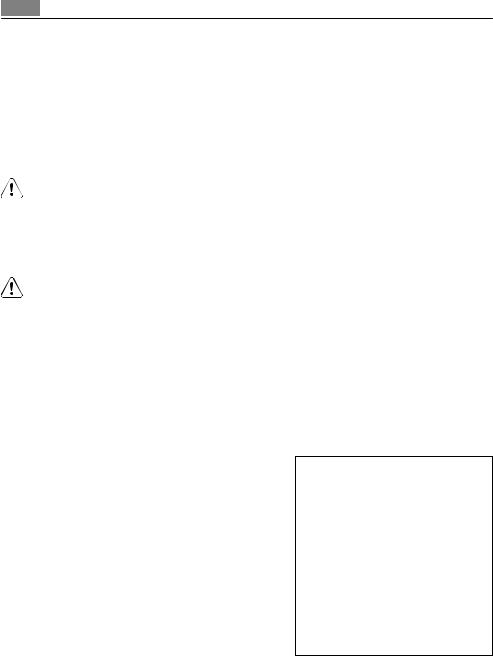
6 Daily use
Daily use
Freezing fresh food
The freezer compartment is suitable for freezing fresh food and storing frozen and deepfrozen food for a long time.
To freeze fresh foods it is not necessary to change the medium setting.
However, for a faster freezing operation, turn the temperature regulator toward higher settings to obtain the maximum coldness.
In this condition, the refrigerator compartment temperature might drop below 0°C. If this occurs reset the temperature regulator to a warmer setting.
Storage of frozen food
When first starting-up or after a period out of use, before putting the products in the compartment let the appliance run at least 2 hours on the higher settings.
In the event of accidental defrosting, for example due to a power failure, if the power has been off for longer than the value shown in the technical characteristics chart under "rising time", the defrosted food must be consumed quickly or cooked immediately and then refrozen (after cooling).
Thawing
Deep-frozen or frozen food, prior to being used, can be thawed in the refrigerator compartment or at room temperature, depending on the time available for this operation. Small pieces may even be cooked still frozen, directly from the freezer: in this case, cooking will take longer.
Movable shelves
The walls of the refrigerator are equipped with a series of runners so that the shelves can be posi-
tioned as desired. For better use of space, the front half-shelves can
lie over the rear ones.
Positioning the door half shelf
The door half shelf can be placed at different heights. To make these adjustments proceed as follow:
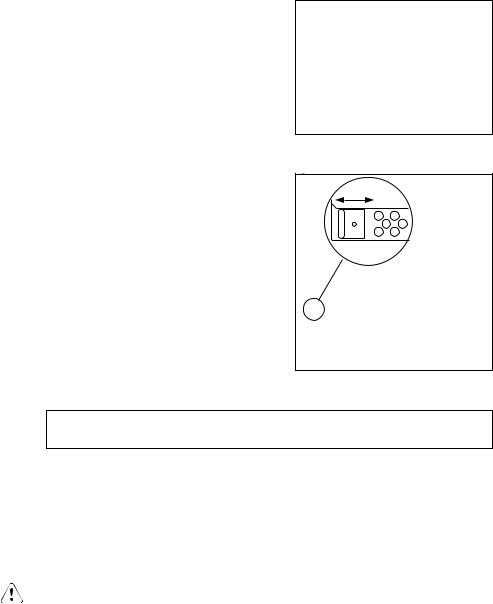
Helpful hints and tips |
7 |
|
|
1. lift the shelf with the door half shelf upwards and out of the holders in the door 2. remove the retaining bracket out of the
guide under the shelf
3. Reverse the above operation to insert the half shelf at a different height.
Humidity control
The glass shelf incorporates a device with slits (adjustable by means of a sliding lever), which makes it possible to regulate the temperature in the vegetable drawer(s).
When the ventilation slots are closed:
the natural moisture content of the food in the fruit and vegetable compartments is preserved for longer.
When the ventilation slots are opened:
more air circulation results in a lower air moisture content in the fruit and vegetable compartments.
Freezing Calendar
The symbols show different types of frozen goods.
The numbers indicate storage times in months for the appropriate types of frozen goods. Whether the upper or lower value of the indicated storage time is valid depends on the quality of the foods and treating before freezing.
Ice-cube production
This appliance is equipped with one or more trays for the production of ice-cubes. Fill these trays with water, then put them in the freezer compartment.
Do not use metallic instruments to remove the trays from the freezer.
Helpful hints and tips
Hints for energy saving
• Do not open the door frequently or leave it open longer than absolutely necessary.

8Helpful hints and tips
•If the ambient temperature is high and the Temperature Regulator is set to low temperature and the appliance is fully loaded, the compressor may run continuously, causing frost or ice on the evaporator. If this happens, set the Temperature Regulator toward warmer settings to allow automatic defrosting and so a saving in electricity consumption.
Hints for fresh food refrigeration
To obtain the best performance:
•do not store warm food or evaporating liquids in the refrigerator
•do cover or wrap the food, particularly if it has a strong flavour
•position food so that air can circulate freely around it
Hints for refrigeration
Useful hints:
Meat (all types) : wrap in polythene bags and place on the glass shelf above the vegetable drawer.
For safety, store in this way only one or two days at the most.
Cooked foods, cold dishes, etc..: these should be covered and may be placed on any shelf. Fruit and vegetables: these should be thoroughly cleaned and placed in the special drawer(s) provided.
Butter and cheese: these should be placed in special airtight containers or wrapped in aluminium foil or polythene bags to exclude as much air as possible.
Milk bottles: these should have a cap and should be stored in the bottle rack on the door. Bananas, potatoes, onions and garlic, if not packed, must not be kept in the refrigerator.
Hints for freezing
To help you make the most of the freezing process, here are some important hints:
•the maximum quantity of food which can be frozen in 24 hrs. is shown on the rating plate;
•the freezing process takes 24 hours. No further food to be frozen should be added during this period;
•only freeze top quality, fresh and thoroughly cleaned, foodstuffs;
•prepare food in small portions to enable it to be rapidly and completely frozen and to make it possible subsequently to thaw only the quantity required;
•wrap up the food in aluminium foil or polythene and make sure that the packages are airtight;
•do not allow fresh, unfrozen food to touch food which is already frozen, thus avoiding a rise in temperature of the latter;
•lean foods store better and longer than fatty ones; salt reduces the storage life of food;
•water ices, if consumed immediately after removal from the freezer compartment, can possibly cause the skin to be freeze burnt;
•it is advisable to show the freezing in date on each individual pack to enable you to keep tab of the storage time.
Hints for storage of frozen food
To obtain the best performance from this appliance, you should:
•make sure that the commercially frozen foodstuffs were adequately stored by the retailer;

Care and cleaning |
9 |
|
|
•be sure that frozen foodstuffs are transferred from the foodstore to the freezer in the shortest possible time;
•not open the door frequently or leave it open longer than absolutely necessary.
•Once defrosted, food deteriorates rapidly and cannot be refrozen.
•Do not exceed the storage period indicated by the food manufacturer.
Care and cleaning
CAUTION!
Unplug the appliance before carrying out any maintenance operation.
This appliance contains hydrocarbons in its cooling unit; maintenance and recharging must therefore only be carried out by authorized technicians.
Periodic cleaning
The equipment has to be cleaned regularly:
•clean the inside and accessories with lukewarm water and some neutral soap.
•regularly check the door seals and wipe clean to ensure they are clean and free from debris.
•rinse and dry thoroughly.
Do not pull, move or damage any pipes and/or cables inside the cabinet.
Never use detergents, abrasive powders, highly perfumed cleaning products or wax polishes to clean the interior as this will damage the surface and leave a strong odour.
Clean the condenser (black grill) and the compressor at the back of the appliance with a brush or a vacuum cleaner. This operation will improve the performance of the appliance and save electricity consumption.
Take care of not to damage the cooling system.
Many proprietary kitchen surface cleaners contain chemicals that can attack/damage the plastics used in this appliance. For this reason it is recommended that the outer casing of this appliance is only cleaned with warm water with a little washing-up liquid added.
After cleaning, reconnect the equipment to the mains supply.
Defrosting of the refrigerator
Frost is automatically eliminated from the evaporator of the refrigerator compartment every time the motor compressor stops, during normal use. The defrost water drains out through a trough into a special container at the back of the appliance, over the motor compressor, where it evaporates.
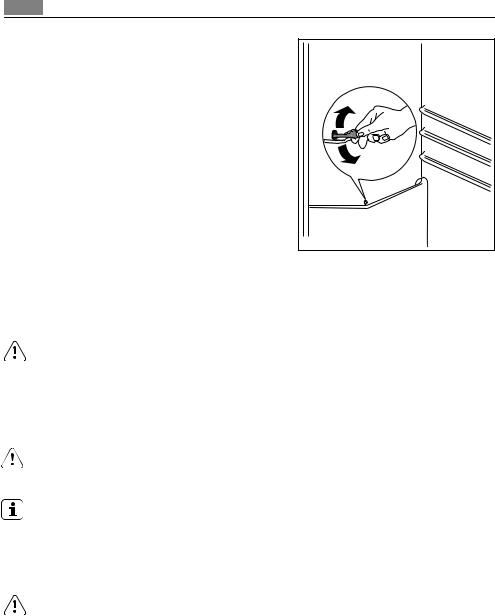
10 Care and cleaning
It is important to periodically clean the defrost water drain hole in the middle of the refrigerator compartment channel to prevent the water overflowing and dripping onto the food inside. Use the special cleaner provided, which you will find already inserted into the drain hole.
Defrosting the freezer
A certain amount of frost will always form on the freezer shelves and around the top compartment.
Defrost the freezer when the frost layer reaches a thickness of about 3-5 mm.
About 12 hours prior to defrosting, set the Temperature regulator toward higher settings , in order to build up sufficient chill reserve for the interruption in operation.
To remove the frost, follow the instructions below:
1.Switch off the appliance.
2.Remove any stored food, wrap it in several layers of newspaper and put it in a cool place.
CAUTION!
Do not touch frozen goods with wet hands. Hands can freeze to the goods. 3. Leave the door open .
In order to speed up the defrosting process, place a pot of warm water in the freezer compartment. In addition, remove pieces of ice that break away before defrosting is complete.
4.When defrosting is completed, dry the interior thoroughly.
5.Switch on the appliance.
6.After two or three hours, reload the previously removed food into the compartment.
Never use sharp metal tools to scrape off frost from the evaporator as you could damage it.
Do not use a mechanical device or any artificial means to speed up the thawing process other than those recommended by the manufacturer.
A temperature rise of the frozen food packs, during defrosting, may shorten their safe storage life.
Periods of non-operation
When the appliance is not in use for long periods, take the following precautions:

What to do if… 11
•disconnect the appliance from electricity supply
•remove all food
•defrost 3)and clean the appliance and all accessories
•leave the door/doors ajar to prevent unpleasant smells.
If the cabinet will be kept on, ask somebody to check it once in a while to prevent the food inside from spoiling in case of a power failure.
What to do if…
WARNING!
Before troubleshooting, disconnect the mains plug from the mains socket.
Only a qualified electrician or competent person must do the troubleshooting that is not in this manual.
There are some sounds during normal use (compressor, refrigerant circulation).
Problem |
|
Possible cause |
|
Solution |
|
|
|
|
|
The appliance does not |
|
The appliance is switched off. |
|
Switch on the appliance. |
operate. The lamp does |
|
|
|
|
not operate. |
|
|
|
|
|
|
|
|
|
|
|
The mains plug is not connected |
|
Connect the mains plug to the |
|
|
to the mains socket correctly. |
|
mains socket correctly. |
|
|
|
|
|
|
|
The appliance has no power. |
|
Connect a different electrical ap- |
|
|
There is no voltage in the mains |
|
pliance to the mains socket. |
|
|
socket. |
|
Contact a qualified electrician. |
|
|
|
|
|
The lamp does not work. |
|
The lamp is in stand-by. |
|
Close and open the door. |
|
|
|
|
|
|
|
The lamp is defective. |
|
Refer to "Replacing the lamp". |
|
|
|
|
|
The compressor operates |
|
The temperature is not set cor- |
|
Set a higher temperature. |
continually. |
|
rectly. |
|
|
|
|
|
|
|
|
|
The door is not closed correctly. |
|
Refer to "Closing the door". |
|
|
|
|
|
|
|
The door has been opened too |
|
Do not keep the door open longer |
|
|
frequently. |
|
than necessary. |
|
|
|
|
|
|
|
The product temperature is too |
|
Let the product temperature de- |
|
|
high. |
|
crease to room temperature be- |
|
|
|
|
fore storage. |
|
|
|
|
|
|
|
The room temperature is too |
|
Decrease the room temperature. |
|
|
high. |
|
|
|
|
|
|
|
Water flows on the rear |
|
During the automatic defrosting |
|
This is correct. |
plate of the refrigerator. |
|
process, frost defrosts on the |
|
|
|
|
rear plate. |
|
|
Water flows into the re- |
|
The water outlet is clogged. |
|
Clean the water outlet. |
frigerator. |
|
|
|
|
|
|
|
|
|
3) If foreseen.

12 |
What to do if… |
|
|
|
|
|
|
|
|
|
|
|
|
|
|
|
|
|
Problem |
|
Possible cause |
|
Solution |
|
|
|
|
|
|
|
|
|
Products prevent that water |
|
Make sure that products do not |
|
|
|
flows into the water collector. |
|
touch the rear plate. |
|
|
|
|
|
|
|
Water flows on the |
|
The melting water outlet does |
|
Attach the melting water outlet |
|
ground. |
|
not flow in the evaporative tray |
|
to the evaporative tray. |
|
|
|
above the compressor. |
|
|
|
|
|
|
|
|
|
The temperature in the |
|
The temperature regulator is not |
|
Set a higher temperature. |
|
appliance is too low. |
|
set correctly. |
|
|
|
|
|
|
|
|
|
The temperature in the |
|
The temperature regulator is not |
|
Set a lower temperature. |
|
appliance is too high. |
|
set correctly. |
|
|
|
|
|
|
|
|
|
|
|
The door is not closed correctly. |
|
Refer to "Closing the door". |
|
|
|
|
|
|
|
|
|
The product temperature is too |
|
Let the product temperature de- |
|
|
|
high. |
|
crease to room temperature be- |
|
|
|
|
|
fore storage. |
|
|
|
|
|
|
|
|
|
Many products are stored at the |
|
Store less products at the same |
|
|
|
same time. |
|
time. |
|
|
|
|
|
|
|
|
|
There is no cold air circulation in |
|
Make sure that there is cold air |
|
|
|
the appliance. |
|
circulation in the appliance. |
|
|
|
|
|
|
Replacing the lamp
1.Disconnect the mains plug from the mains socket.
2.Remove the screw from the lamp cover.
3.Remove the lamp cover (refer to the il-
lustration).
4. Replace the used lamp with a new lamp of the same power (the maximum power is shown on the lamp cover).
5. Install the lamp cover.
6.Tighten the screw to the lamp cover.
7.Connect the mains plug to the mains socket.
8.Open the door. Make sure that the lamp comes on.
Closing the door
1.Clean the door gaskets.
2.If necessary, adjust the door. Refer to "Installation".
3.If necessary, replace the defective door gaskets. Contact the Service Center.

|
|
|
|
Technical data |
13 |
|
|
|
|||
Technical data |
|
|
|||
|
|
|
|
|
|
|
|
|
|
|
|
|
|
|
|
||
|
Dimension of the recess |
|
|
|
|
|
|
|
|
|
|
|
|
|
Height |
1580 mm |
|
|
|
|
|
|
|
|
|
|
Width |
560 mm |
|
|
|
|
|
|
|
|
|
|
Depth |
550 mm |
|
|
|
|
|
||
|
Rising Time |
|
|
20 h |
|
|
|
|
|
|
|
The technical information are situated in the rating plate on the internal left side of the appliance and in the energy label.
Installation
WARNING!
Read the "Safety Information" carefully for your safety and correct operation of the appliance before installing the appliance.
Positioning
Install this appliance at a location where the ambient temperature corresponds to the climate class indicated on the rating plate of the appliance:
Climate class |
|
Ambient temperature |
|
|
|
SN |
|
+10°C to + 32°C |
|
|
|
N |
|
+16°C to + 32°C |
|
|
|
ST |
|
+16°C to + 38°C |
|
|
|
T |
|
+16°C to + 43°C |
|
|
|
Electrical connection
Before plugging in, ensure that the voltage and frequency shown on the rating plate correspond to your domestic power supply.
The appliance must be earthed. The power supply cable plug is provided with a contact for this purpose. If the domestic power supply socket is not earthed, connect the appliance to a separate earth in compliance with current regulations, consulting a qualified electrician. The manufacturer declines all responsibility if the above safety precautions are not observed.
This appliance complies with the E.E.C. Directives.
Door reversibility
The door of the appliance opens to the right. If you want to open the door to the left, do these steps before you install the appliance:

14Installation
1.Loosen and remove the upper pin.
2.Remove the upper door.
3.Remove the spacer.
4.Loosen the middle hinge.
5.Remove the lower door.
6. Loosen and remove the lower pin. On the opposite side:
1.Tighten the lower pin.
2.Install the lower door.
3.Tighten the middle hinge.
4.Install the spacer.
5.Install the upper door.
6.Tighten the upper pin.

Installation 15
Ventilation requirements
The airflow behind the appliance must be sufficient.
50 mm |
min. |
|
200 cm2 |
|
min. |
|
200 cm2 |
Installing the appliance
CAUTION!
Make sure that the mains cable can move freely.
Do these steps.
1.Apply the adhesive sealing strip to the appliance as shown in figure.

16Installation
2.Install the appliance in the niche.
Push the appliance in the direction of the arrow (1) until the upper gap cover stops against the kitchen furniture.
Push the appliance in the direction of the arrow (2) against the cupboard on the opposite side of the hinge.
 1
1
3.Adjust the appliance in the niche.
Make sure that the distance between the appliance and the cupboard front-edge is 44 mm.
The lower hinge cover (in the accessories bag) makes sure that the distance between the appliance and the kitchen furniture is correct.
Make sure that the clearance between the appliance and the cupboard is 4 mm.
Open the door. Put the lower hinge cover in position.
4mm |
44mm |
4.Attach the appliance to the niche with 4 screws.
I |
I |
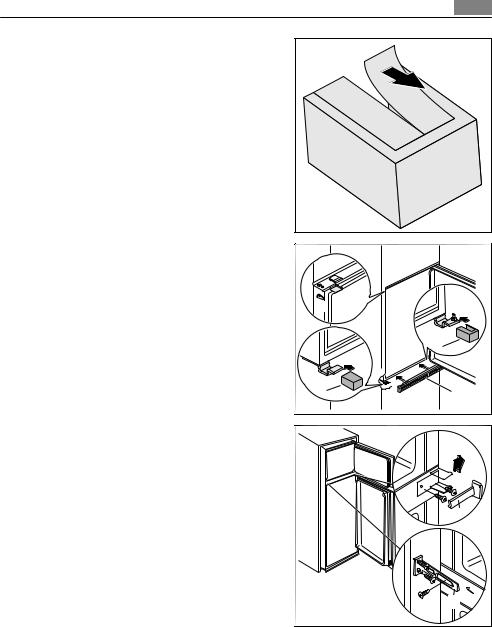
|
|
|
Installation |
17 |
5. |
Remove the correct part from the hinge |
|
|
|
|
cover (E). Make sure to remove the part |
|
|
|
|
DX, in the case of right hinge, SX in op- |
|
|
|
|
posite case. |
|
|
|
6. |
Attach the covers (C, D) to the lugs and |
|
|
|
|
the hinge holes. |
|
|
|
|
Install the vent grille (B). |
|
C |
|
|
Attach the hinge covers (E) to the hinge. |
D |
|
|
|
|
|
E |
|
|
|
E |
|
B |
7.Connect the appliance laterally to the kitchen furniture sidewall:
a)Loosen the screws of the part (G) and move the part (G) till the furniture sidewall.
b)Tighten the screws of the part (G) again.
c)Attach the part (H) to the part (G).

 G H
G H
G 

18 Installation
8.Disconnect the parts (Ha), (Hb), (Hc) and (Hd)
9.Install the part (Ha) on the inner side of the kitchen furniture.
10. Push the part (Hc) on the part (Ha).
ca. 50 mm |
|
|
90° |
|
21 mm |
|
90° |
ca. 50 mm |
21 mm |
|
|
Ha |
|
Hc

|
Installation |
19 |
11. Open the appliance door and the kitchen |
|
|
furniture door at an angle of 90°. |
8 mm |
|
Insert the small square (Hb) into guide |
|
|
(Ha). |
|
|
Put together the appliance door and the |
|
|
furniture door and mark the holes. |
|
|
|
|
Ha |
|
Hb |
|
12.Remove the brackets and mark a distance of 8 mm from the outer edge of the door where the nail must be fitted
(K).
13.Place the small square on the guide again and fix it with the screws supplied.
Align the kitchen furniture door and the appliance door by adjusting the part Hb.
8 mm |
K |
Ha |
Hb |
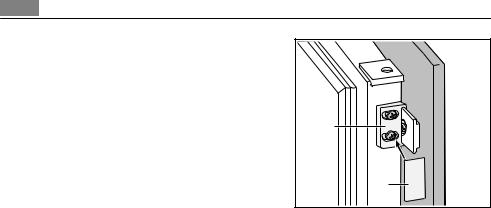
20 Environmental concerns
14. Press the part (Hd) on the part (Hb). Do a final check to make sure that:
•All screws are tightened.
•The sealing strip is attached tightly to the cabinet.
•The door opens and closes correctly.
Hb |
Hd |
Environmental concerns
The symbol  on the product or on its packaging indicates that this product may not be treated as household waste. Instead it should be taken to the appropriate collection point for the recycling of electrical and electronic equipment. By ensuring this product is disposed of correctly, you will help prevent potential negative consequences for the environment and human health, which could otherwise be caused by inappropriate waste handling of this product. For more detailed information about recycling of this product, please contact your local council, your household waste disposal service or the shop where you purchased the product.
on the product or on its packaging indicates that this product may not be treated as household waste. Instead it should be taken to the appropriate collection point for the recycling of electrical and electronic equipment. By ensuring this product is disposed of correctly, you will help prevent potential negative consequences for the environment and human health, which could otherwise be caused by inappropriate waste handling of this product. For more detailed information about recycling of this product, please contact your local council, your household waste disposal service or the shop where you purchased the product.

Sommaire 21
Nous vous remercions d’avoir choisi l’un de nos produits de qualité.
Afin de garantir une performance optimale et constante de votre appareil, veuillez lire attentivement cette notice d'utilisation. Il vous permettra d’utiliser correctement et efficacement toutes les fonctions de l’appareil. Nous vous recommandons de conserver cette notice à proximité pour une utilisation rapide et optimale. Si l'appareil devez être vendu ou cédé à une autre personne, assurez-vous que la notice d'utilisation l'accompagne.
Nous vous souhaitons beaucoup de plaisir avec votre nouvel appareil.
Sommaire
Consignes de sécurité |
21 |
Sécurité des enfants et des personnes |
|
vulnérables |
22 |
Sécurité générale |
22 |
Utilisation quotidienne |
23 |
Entretien et nettoyage |
23 |
Installation |
23 |
Maintenance |
24 |
Fonctionnement |
24 |
Mise en fonctionnement |
24 |
Mise à l'arrêt |
24 |
Réglage de la température |
24 |
Première utilisation |
25 |
Nettoyage intérieur |
25 |
Utilisation quotidienne |
25 |
Congélation d'aliments frais |
25 |
Conservation des aliments congelés |
25 |
La décongélation |
25 |
Clayettes amovibles |
26 |
Emplacement du demi-balconnet |
26 |
Contrôle de l'humidité |
26 |
Guide de congélation |
27 |
Fabrication de glaçons |
27 |
Conseils utiles |
27 |
Conseils pour l'économie d'énergie |
27 |
Conseils pour la réfrigération de denrées |
|
fraîches |
27 |
Conseils pour la réfrigération |
27 |
Conseils pour la congélation |
28 |
Conseils pour la conservation des produits |
|
surgelés et congelés du commerce |
28 |
Entretien et nettoyage |
28 |
Nettoyage périodique |
28 |
Dégivrage du réfrigérateur |
29 |
Dégivrage du congélateur |
29 |
En cas d'absence prolongée ou de non- |
|
utilisation |
30 |
En cas d'anomalie de fonctionnement |
30 |
Remplacement de l'ampoule d'éclairage |
32 |
|
|
Fermeture de la porte |
32 |
Caractéristiques techniques |
32 |
Installation |
33 |
Emplacement |
33 |
Branchement électrique |
33 |
Réversibilité de la porte |
33 |
Ventilation |
34 |
Installation de l'appareil |
34 |
En matière de sauvegarde de l'environnement
39
Sous réserve de modifications
Consignes de sécurité
Pour votre sécurité et garantir une utilisation correcte de l'appareil, lisez attentivement cette notice, y compris les conseils et avertissements, avant d'installer et d'utiliser l'appareil pour la première fois. Pour éviter toute erreur ou accident, veillez à ce que toute personne

22 Consignes de sécurité
qui utilise l'appareil connaisse bien son fonctionnement et ses fonctions de sécurité. Conservez cette notice avec l'appareil. Si l'appareil doit être vendu ou cédé à une autre personne, veillez à remettre cette notice au nouveau propriétaire, afin qu'il puisse se familiariser avec son fonctionnement et sa sécurité.
Pour la sécurité des personnes et des biens, conservez et respectez les consignes de sécurité figurant dans cette notice. Le fabricant décline toute responsabilité en cas de dommages dus au non-respect de ces instructions.
Sécurité des enfants et des personnes vulnérables
•Cet appareil n'est pas destiné à être utilisé par des enfants ou des personnes dont les capacités physiques, sensorielles ou mentales, ou le manque d'expérience et de connaissance les empêchent d'utiliser l'appareil sans risque lorsqu'ils sont sans surveillance ou en l'absence d'instruction d'une personne responsable qui puisse leur assurer une utilisation de l'appareil sans danger.
Empêchez les enfants de jouer avec l'appareil.
•Ne laissez pas les différents emballages à portée des enfants. Ils pourraient s'asphyxier.
•Si l'appareil doit être mis au rebut, veillez à couper le câble d'alimentation électrique au ras de l'appareil pour éviter les risques d'électrocution. Démontez la porte pour éviter que des enfants ne restent enfermés à l'intérieur.
•Cet appareil est muni de fermetures magnétiques. S'il remplace un appareil équipé d'une fermeture à ressort, nous vous conseillons de rendre celle-ci inutilisable avant de vous en débarrasser. Ceci afin d'éviter aux enfants de s'enfermer dans l'appareil et de mettre ainsi leur vie en danger.
Sécurité générale
ATTENTION
Veillez à ce que les orifices de ventilation ne soient pas obstrués.
•Cet appareil est destiné uniquement à la conservation d'aliments et/ou de boissons dans le cadre d'un usage domestique normal, tel que celui décrit dans la présente notice.
•N'utilisez pas de dispositifs mécaniques ou autres moyens artificiels pour accélérer le dégivrage de l'appareil.
•N'utilisez pas d'autres appareils électriques (par exemple, sorbetières) à l'intérieur d'appareils réfrigérants sauf s'ils sont homologués pour cet usage par leur fabricant.
•N'endommagez pas le circuit de refroidissement.
•Le circuit de refroidissement de l'appareil contient de l'isobutane (R600a), un gaz naturel offrant un haut niveau de compatibilité avec l'environnement mais qui est néanmoins inflammable.
Pendant le transport et l'installation de l'appareil, assurez-vous qu'aucune pièce du circuit de refroidissement n'est endommagée.
Si tel est le cas :
–évitez les flammes vives et les sources d'ignition
–aérez soigneusement la pièce où se trouve l'appareil
•Il est dangereux de modifier les caractéristiques de l'appareil ou l'appareil. Un cordon d'alimentation endommagé peut être la cause de courts-circuits, d'incendies et/ou de décharges électriques.

Consignes de sécurité |
23 |
|
|
AVERTISSEMENT
Les composants électriques (cordon d'alimentation, prise, compresseur) doivent être remplacés par un technicien d'entretien agréé ou par un électricien spécialisé.
1.Ne branchez pas le cordon d'alimentation à une rallonge.
2.Assurez-vous que la prise n'est pas écrasée ou endommagée par l'arrière de l'appareil. Une prise de courant endommagée peut s'échauffer et provoquer un incendie.
3.Assurez-vous de pouvoir accéder à la prise secteur de l'appareil.
4.Ne tirez pas sur le cordon d'alimentation.
5.Si la fiche du cordon d'alimentation est desserrée, ne la branchez pas sur la prise murale. Risque d'électrocution ou d'incendie.
6.N'utilisez pas l'appareil si le diffuseur de l'ampoule d'éclairage n'est pas présent 4) pour l'éclairage intérieur.
•Cet appareil est lourd. Faites attention lors de son déplacement.
•Ne touchez pas les produits congelés sortant du congélateur avec les mains humides car ceci peut provoquer des abrasions ou des brûlures cutanées.
•Évitez les expositions prolongées de l'appareil aux rayons solaires.
Utilisation quotidienne
•Ne posez pas d'éléments chauds sur les parties en plastique de l'appareil.
•Ne stockez pas de gaz et de liquides inflammables dans l'appareil (risque d'explosion).
•Respectez scrupuleusement les conseils de conservation donnés par le fabricant de l'appareil. Consultez les instructions respectives.
Entretien et nettoyage
•Avant toute opération d'entretien, mettez l'appareil à l'arrêt et débranchez-le.
•N'utilisez pas d'objets métalliques pour nettoyer l'appareil.
•Contrôlez régulièrement l'orifice d'évacuation de l'eau de dégivrage dans le compartiment réfrigérateur. Nettoyez-le, le cas échéant. Si l'orifice est bouché, l'eau s'écoulera en bas de l'appareil.
Installation
Avant de procéder au branchement électrique, respectez scrupuleusement les instructions fournies dans cette notice.
•Déballez l'appareil et vérifiez qu'il n'est pas endommagé. Ne branchez pas l'appareil s'il est endommagé. Signalez immédiatement au revendeur de l'appareil les dommages constatés. Dans ce cas, gardez l'emballage.
•Il est conseillé d'attendre au moins quatre heures avant de brancher l'appareil pour que le circuit frigorifique soit stabilisé.
•Veillez à ce que l'air circule librement autour de l'appareil pour éviter qu'il ne surchauffe. Pour assurer une ventilation suffisante, respectez les instructions de la notice (chapitre Installation).
•Placez l'appareil dos au mur pour éviter tout contact avec le compresseur et le condenseur (risque de brûlure).
•Placez de préférence votre appareil loin d'une source de chaleur (chauffage, cuisson ou rayons solaires trop intenses).
4) Si le diffuseur est prévu

24Fonctionnement
•Assurez-vous que la prise murale reste accessible après l'installation de l'appareil.
•Branchez à l'alimentation en eau potable uniquement. 5)
Maintenance
•Les branchements électriques nécessaires à l'entretien de l'appareil doivent être réalisés par un électricien qualifié ou une personne compétente.
•Cet appareil ne doit être entretenu et réparé que par un Service après-vente autorisé, exclusivement avec des pièces d'origine.
Protection de l'environnement
Le système frigorifique et l'isolation de votre appareil ne contiennent pas de C.F.C. contribuant ainsi à préserver l'environnement. L'appareil ne doit pas être mis au rebut avec les ordures ménagères et les déchets urbains. La mousse d'isolation contient des gaz inflammables : l'appareil sera mis au rebut conformément aux règlements applicables disponibles auprès des autorités locales. Veillez à ne pas détériorer les circuits frigorifiques, notamment au niveau du condenseur. Les matériaux utilisés dans cet appareil identifiés par le symbole
 sont recyclables.
sont recyclables.
Fonctionnement
Mise en fonctionnement
Branchez l'appareil sur une prise murale.
Tournez le bouton du thermostat dans le sens des aiguilles d'une montre sur une position moyenne.
Mise à l'arrêt
Pour mettre à l'arrêt l'appareil, tournez le bouton du thermostat sur la position "O".
Réglage de la température
La température est réglée automatiquement.
Pour faire fonctionner l'appareil, procédez comme suit :
•tournez le bouton du thermostat vers le bas pour obtenir un réglage de froid minimum.
•tournez le bouton du thermostat vers le haut pour obtenir un réglage de froid maximum.
Une position moyenne est la plus indiquée.
Toutefois, le réglage doit être choisi en tenant compte du fait que la température à l'intérieur de l'appareil dépend de plusieurs facteurs :
•la température ambiante
•la fréquence d'ouverture de la porte
•la quantité de denrées stockées
•l'emplacement de l'appareil.
5) Si un branchement sur le réseau d'eau est prévu
